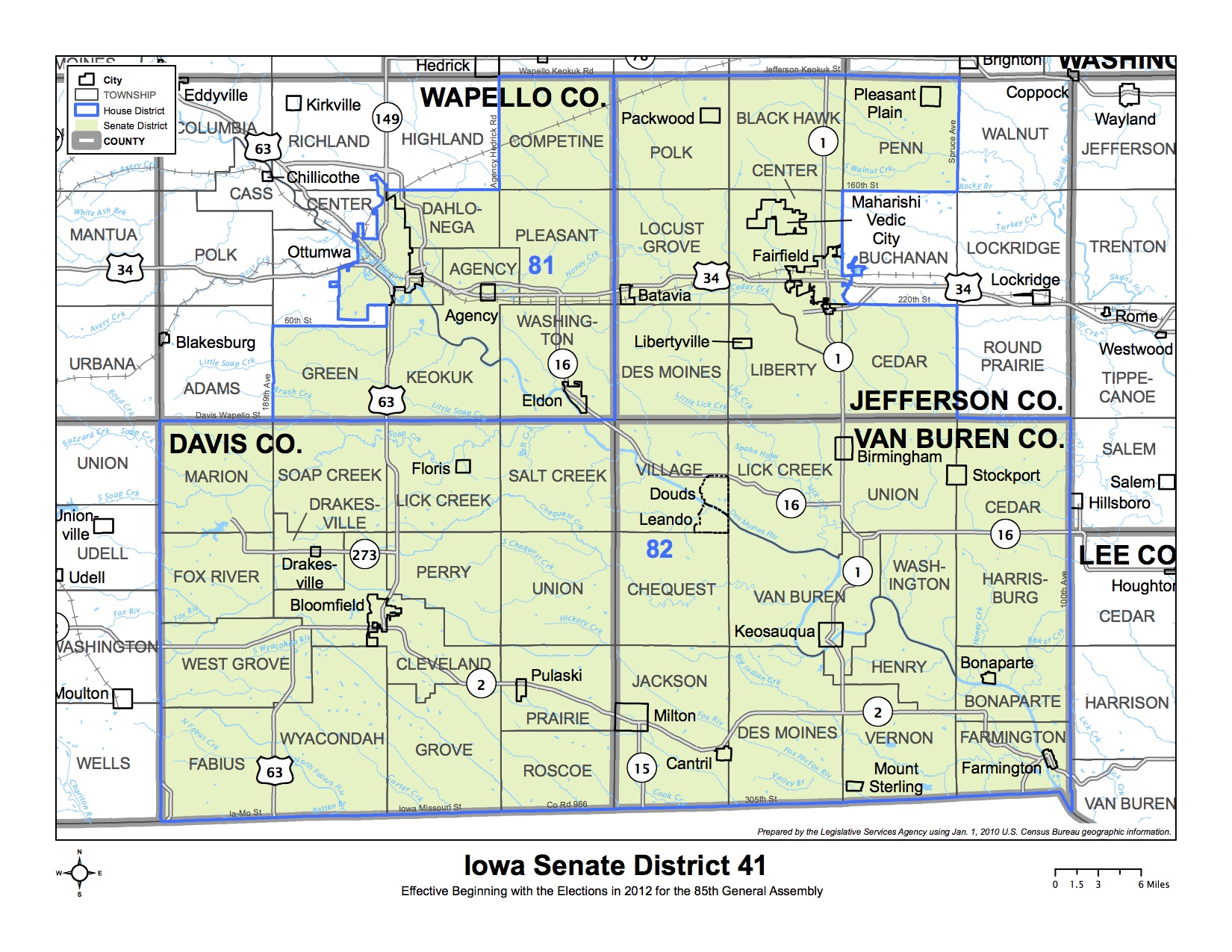Republican Adrian Dickey will represent Iowa Senate district 41 for the next two years, with unofficial results showing him winning the January 26 special election by 5,040 votes to 4,074 for Democrat Mary Stewart (55.3 percent to 44.7 percent). The victory gives the GOP a 32 to 18 majority in the Iowa Senate.
Stewart led the early vote in her home county of Wapello (Ottumwa area) and in Jefferson County, which contains Democratic-leaning Fairfield as well as Dickey’s home town of Packwood. But even a massive snowstorm on the eve of the election couldn’t stop Dickey from overtaking her in Wapello.
| Unofficial results from the Senate district 41 special election | ||||
| County | Dickey votes | Dickey vote share | Stewart votes | Stewart vote share |
|---|---|---|---|---|
| Wapello | 1,752 | 51.1% | 1,678 | 48.9% |
| Jefferson | 1,370 | 43.5% | 1,779 | 56.5% |
| Davis | 913 | 72.6% | 344 | 27.4% |
| Van Buren | 1,005 | 78.6% | 273 | 21.4% |
| total | 5,040 | 55.3% | 4,074 | 44.7% |
I generally avoid drawing big conclusions from low-turnout special election races. Republicans heavily outspent Democrats on direct mail and television and radio advertising, and appear to have had a strong ground game during this unusually brief campaign. Dickey’s winning margin was larger than Mariannette Miller-Meeks’ in her 2018 general election win against Stewart, but smaller than Donald Trump’s 21-point advantage over Joe Biden in the 2020 general election.
For now, I want to highlight what I see as the most alarming trend for Iowa Democrats: their candidates’ declining vote share in mid-sized counties, containing cities with populations between 20,000 and 30,000.
Wapello is a prime example of the phenomenon. Ottumwa (population just over 24,000) was a Democratic stronghold for decades. A high concentration of union households made Wapello one of only six Iowa counties to vote for John F. Kennedy in 1960 and one of only four to vote for Bonnie Campbell in the 1994 governor’s race.
Although labor unions have been in decline in Ottumwa since at least the Hormel strike during the mid-1980s, Wapello County continued to vote for Democratic candidates until recently.
| Wapello County election results | ||||
| County | Republican votes | Republican vote share | Democratic votes | Democratic vote share |
|---|---|---|---|---|
| 1992 presidential | 4,852 | 30.2% | 8,670 | 53.9% |
| 1994 governor | 5,560 | 47.8% | 5,733 | 49.3% |
| 1996 presidential | 4,828 | 32.7% | 8,437 | 57.1% |
| 1998 governor | 4,432 | 37.5% | 7,205 | 60.9% |
| 2000 presidential | 6,313 | 41.7% | 8,355 | 55.2% |
| 2002 governor | 4,928 | 37.1% | 7,967 | 60.0% |
| 2004 presidential | 7,403 | 44.3% | 9,125 | 54.6% |
| 2006 governor | 4,011 | 35.2% | 7,178 | 63.0% |
| 2008 presidential | 6,663 | 41.5% | 8,820 | 54.9% |
| 2010 governor | 5,611 | 46.8% | 5,501 | 45.9% |
| 2012 presidential | 6,789 | 42.9% | 8,663 | 54.7% |
| 2014 governor | 5,986 | 54.1% | 4,461 | 40.3% |
| 2016 presidential | 8,715 | 57.0% | 5,594 | 36.6% |
| 2018 governor | 6,313 | 52.4% | 5,480 | 45.5% |
| 2020 presidential | 9,516 | 60.5% | 5,821 | 37.0% |
When Democratic incumbent Keith Kreiman lost to GOP challenger Mark Chelgren by ten votes in the Iowa Senate district containing Ottumwa in 2010, many Democrats wrote it off as a fluke of a wave year. In retrospect, that race looks more like the start of a trend than an anomaly.
Over the past decade, Democrats lost more Iowa House or Senate races in districts containing mid-sized cities (Muscatine, Fort Dodge, Burlington, Marshalltown, Clinton, Newton). Most recently, Democratic incumbents lost 2020 state House races in districts that include Ottumwa and Keokuk.
I don’t mean to discount the importance of improving Democratic performance in Iowa’s rural areas. Running up the score in Davis and Van Buren counties gave Dickey a cushion that could have absorbed a modest advantage for Stewart in Wapello.
As it turned out, he didn’t need that cushion, because the Ottumwa area can no longer be considered friendly territory for Democrats.
I don’t have the solution, but the Iowa Democratic Party’s new leadership team needs to address the erosion of support in counties like Wapello to have any hope of winning statewide elections in 2022.


